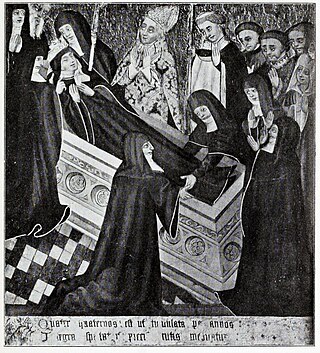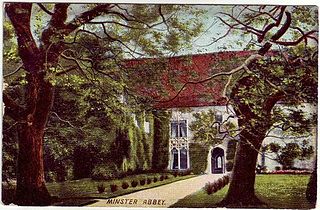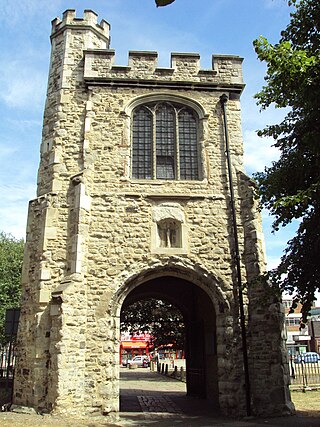Related Research Articles

Eadburh was the daughter of King Edward the Elder of England and his third wife, Eadgifu of Kent. She lived most of her life as a nun known for her singing ability. Most of the information about her comes from hagiographies written several centuries after her life. She was canonised twelve years after her death and there are a small number of churches dedicated to her, most of which are located near Worcestershire, where she lived.

Minster, also known as Minster-in-Thanet, is a village and civil parish in the Thanet District of Kent, England. It is the site of Minster in Thanet Priory. The village is west of Ramsgate and to the north east of Canterbury; it lies just south west of Kent International Airport and just north of the River Stour. Minster is also the "ancient capital of Thanet". At the 2011 Census the hamlet of Ebbsfleet was included.

Eadburh of Bicester was an English nun, abbess, and saint from the 7th century. She has been called a "bit of a mystery"; there have been several Saxon saints with the same name, so it is difficult to pinpoint which one was Eadburh. It is most likely that Eadburh of Bicester was the daughter of King Penda of Mercia, who was pagan but had several children who were Christians. Eadburgh was born in the now-deserted village of Quarrendon in Buckinghamshire. Her sister was Edith, with whom she co-founded an abbey near Aylesburg; Eadburh probably became abbess at Aylesburg. She was also aunt of Osgyth, whom she trained "in the religious life". There are legends that claim that Edburgh and Edith found Osyth after she had drowned three days earlier and "witnessed her return to life".
The name Edburga may refer to:
Eadburh, also spelled Eadburg, was the daughter of King Offa of Mercia and Queen Cynethryth. She was the wife of King Beorhtric of Wessex, and according to Asser's Life of Alfred the Great she killed her husband by poison while attempting to poison another. She fled to Francia, where she is said to have been offered the chance of marrying Charlemagne, but ruined the opportunity. Instead she was appointed as the abbess of a convent. Here she is said to have fornicated with an English exile. As a result, she was eventually expelled from the monastery and ended her days begging in the streets of Pavia.
Centwine was King of Wessex from c. 676 to 685 or 686, although he was perhaps not the only king of the West Saxons at the time.

Saint Lullus was the first permanent archbishop of Mainz, succeeding Saint Boniface, and first abbot of the Benedictine Hersfeld Abbey. He is historiographically considered the first official sovereign of the Electorate of Mainz.

Leoba, OSB was an Anglo-Saxon Benedictine nun and is recognized as a saint. In 746 she and others left Wimborne Minster in Dorset to join her kinsman Boniface in his mission to the German people. She was a learned woman and was involved in the foundation of nunneries in Kitzingen and Ochsenfurt. She had a leading role in evangelizing the area. Leoba was acclaimed for many miracles: saving a village from fire; saving a town from a terrible storm; protecting the reputation of the nuns in her convent; and saving the life of a fellow nun who was gravely ill – all accomplished through prayer.

Saint Cuthburh or Cuthburg, Cuthburga was the first Abbess of Wimborne Minster. She was the sister of Ine, King of Wessex and was married to the Northumbrian king Aldfrith.

Seaxburh, also Saint Sexburga of Ely, was a Queen as well as an abbess, and is a saint of the Christian Church. She was married to King Eorcenberht of Kent.

Saint Mildrith, also Mildthryth, Mildryth and Mildred,, was a 7th- and 8th-century Anglo-Saxon abbess of the Abbey at Minster-in-Thanet, Kent. She was declared a saint after her death, and, in 1030, her remains were moved to Canterbury.
St. Mary's Abbey, also known as the Nunnaminster, was a Benedictine nunnery in Winchester, Hampshire, England. It was founded between 899 and 902 by Alfred the Great's widow Ealhswith, who was described as the 'builder' of the Nunnaminster in the New Minster Liber Vitae. The first buildings were completed by their son, Edward the Elder. Among the house's early members was Edward's daughter Edburga.
Kyneburga, Kyneswide and Tibba were female members of the Mercian royal family in 7th century England who were venerated as saints.

Domne Eafe, also Domneva, Domne Éue, Æbbe, Ebba, was, according to the Kentish royal legend, a granddaughter of King Eadbald of Kent and the foundress of the double monastery of Minster in Thanet Priory at Minster-in-Thanet during the reign of her cousin King Ecgberht of Kent. A 1000-year-old confusion with her sister Eormenburg means she is often now known by that name. Married to Merewalh of Mercia, she had at least four children. When her two brothers, Æthelred and Æthelberht, were murdered she obtained the land in Thanet to build an abbey, from a repentant King Ecgberht. Her three daughters all went on to become abbesses and saints, the most famous of which, Mildrith, ended up with a shrine in St Augustine's Abbey, Canterbury.
Repton Abbey was an Anglo-Saxon Benedictine abbey in Derbyshire, England. Founded in the 7th century, the abbey was a double monastery, a community of both monks and nuns. The abbey is noted for its connections to various saints and Mercian royalty; two of the thirty-seven Mercian Kings were buried within the abbey's crypt. The abbey was abandoned in 873, when Repton was overrun by the invading Great Heathen Army.

Minster Abbey is the name of two abbeys in Minster-in-Thanet, Kent, England. The first was a 7th-century foundation which lasted until the Dissolution of the Monasteries. Beside its ruins is St Mildred's Priory, a Benedictine community of women founded in 1937.

December 12 - Eastern Orthodox liturgical calendar - December 14
The Kentish Royal Legend is a diverse group of Medieval texts which describe a wide circle of members of the royal family of Kent from the 7th to 8th centuries AD. Key elements include the descendants of Æthelberht of Kent over the next four generations; the establishment of various monasteries, most notably Minster-in-Thanet; and the lives of a number of Anglo-Saxon saints and the subsequent travels of their relics. Although it is described as a legend, and contains a number of implausible episodes, it is placed in a well attested historical context.

Hildelith of Barking, also known as Hildilid or Hildelitha, was an 8th-century Christian saint, from Anglo-Saxon England but was of foreign origin.
References
- 1 2 3 "Edburga (Eadburh, Bugga) of Minster", The Oxford Dictionary of Saints (5 rev) (David Farmer, ed.) OUP, 2011 ISBN 9780199596607
- ↑ "Eadburg/Eadburga, abbess of Minster in Thanet", Epistolae, Columbia University
- ↑ Schieffer, Theodor (1950). "Angelsachsen und Franken: II. Erzbischof Lul und die Anfänge des Mainzer Sprengels". Abhandlungen der Geistes- und Sozialwissenschaftlichen Klass (in German). 20: 1431–1539.
- ↑ "The Abbess Bugga Congratulates Boniface on His Success in Frisia (720)", The Correspondence of St. Boniface : Medieval Sourcebook, Fordham University.
- ↑ Emerton, Ephraim. The Letters of St. Boniface. Records of Civilization: Sources & Studies 31. New York: Columbia University Press, 1940, pp. 25–31.
- ↑ Dunbar, Alice. A Dictionary of Saintly Women, 1904
 This article incorporates text from this source, which is in the public domain .
This article incorporates text from this source, which is in the public domain .
- Stephen, Leslie, ed. (1888). . Dictionary of National Biography . Vol. 16. London: Smith, Elder & Co.